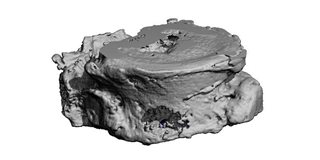
Our bones – like our fingerprints – have their own unique set of identifiers, including mineral density, volume, and skeletal structure. This makes it tricky to create a one-size-fits-all approach for repairing and preventing fractures, especially for cancer patients who experience bone tumors that cause debilitating damage to their long bones and spine. But a biomedical engineer and an aerospace engineer have teamed up to explore how structural metamaterials may offer some solutions by preventing fracture before it happens.
“Bone metastasis patients have a lot of pain,” explained Richard Hall, a professor and biomedical engineer at the University of Leeds. “They can have fractures that can impinge on the spinal cord and cause paralysis. It’s very difficult for them. They just want to sit their grandchildren on their knee and have a reasonable quality of life.”
Metamaterials are fabricated using additive manufacturing. They have complex hierarchical and multiscale characteristics that react and respond to external elements like light, temperature, and other forms of energy. They’re primarily being explored for aerospace applications, explains Rob Hewson, an aeronautics engineer at the Imperial College of London, who is also currently exploring satellite applications for metamaterials.
The idea is that a metamaterial could be created that would first act as a sponge-like substance to be implanted, then expand once applied to the area where the bones have been lost. The metamaterial would then fill and support the damaged area like a temporary patch, stabilizing and holding its form. Hewson said the goal is to design a metamaterial that can mimic the unique structure of a patient’s bone.
“The human body simply has so much uncertainty,” Hewson said. “If implanted into the vertebrae, for example, we don’t want the materials to be a lot stiffer than the vertebrae that are surrounding them. We also don’t want them not to be stiff enough so that they don’t provide support. The key is in tuning the material property by having this kind of hierarchical structure.”  Metamaterials potentially have a variety of applications within the medical industry. Being fabricated via additive manufacturing allows them to conform to various shapes and sizes. In tuning the metamaterials, the team will need to understand the area of bone they are working with. So, the next stage of this work is to develop a system that can accurately identify and predict areas where fractures or lesions may become an issue for a patient.
Metamaterials potentially have a variety of applications within the medical industry. Being fabricated via additive manufacturing allows them to conform to various shapes and sizes. In tuning the metamaterials, the team will need to understand the area of bone they are working with. So, the next stage of this work is to develop a system that can accurately identify and predict areas where fractures or lesions may become an issue for a patient.
“Normally, when people talk about manufacturing in orthopedics, on the spine, they’re talking about manufacturing for traditional implants,” Hall elaborates. “This is a whole new kind of concept. We’re not only designing for the geometry, but also being able to match those mechanical properties, and not just on a personalized basis, but on a lesion-specific basis.”
Hall is exploring building upon the same principles as CT scans and MRIs for the system. He will need to develop advanced modeling to predict how a lesion may progress overtime to ensure that the implant stops imminent fractures and prevents new ones that might arise in the future.
The team is still in the very early stages of the project, but they have big plans. They recently secured more than $9.5 million through the U.K.’s National Health Service and the Engineering and Physical Sciences Research Council (EPSRC) to develop both the metamaterial and the detection/modeling system.
Metamaterials have not previously been considered in this area of study, so the team is well poised to explore other potential applications. Hall recognizes the disparity in breast implant options and believes this may be another promising application for metamaterials.
“Although women make up just over fifty percent of the world’s population, there is very little understanding about the behavior and mechanics of breast tissue,” he said. “So we’d like to develop implants that more reflect the feel, texture, and the biomechanics of breast tissue compared to silicone.”
Regardless of whether the metamaterials are being used for bone or breast implants, the main challenge will be a long-term dependency. Hewson explains that the bone implants they are working on now are not a permanent solution. It is more about offering relief for patients who are in the late stages of the disease.
“At the moment, the state-of-the-art is far from adequate,” Hewson explains. “We can make massive advancements in this area that are much less invasive and improve the quality of life for terminally ill patients.”
Cassandra Martindell is a science and technology writer based in Ohio.

